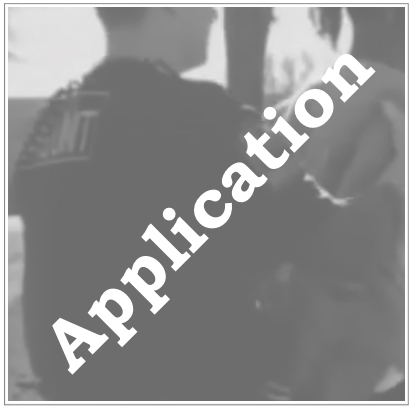Return to Homepage |Return to Practice Section Overview | Return to Practice Section Description
Application Exercise Demonstration
Assessing the Uncomfortable Cluster in a Traffic Stop

In today's exercise
You will be practicing how to assess the Uncomfortable Cluster in a police traffic stop scenario.
Video originally viewed on LawOfficer.com and Mediaite.com
The Workout
1. Watch the video (at least the first 3 minutes of it) of this police traffic stop that takes place in Tulsa, OK to get an idea of what happens.
2. Once you have watched it once, ask yourself the following three questions:
1. What is the first moment that the person displays that the flight response has been triggered? How does that person reveal the uncomfortable cluster?
2. What is the initial stressor that causes the person to display the uncomfortable cluster?
3. What occurs that causes the person to shift from "preparing for flight" to "taking flight?"
Stop! Write your answers on a sheet of paper before scrolling down and being able to view our answers.
View Our Answers
1. What is the first moment that the person displays that the flight response has been triggered? How does that person reveal the uncomfortable cluster?
When he pats his waistband. You don't visually observe this in the video, but you hear the officer ask him why he s touching his waistband while he is still in the car.
2. What is the initial stressor that causes the person to display the uncomfortable cluster?
Getting unexpectedly pulled over by the police, having a gun in his waistband with an officer looking at him from right outside of the window.
3. What occurs that causes the person to shift from "preparing for flight" to "taking flight?"
After stepping out of the car, the officer begins to put him in handcuffs while saying "if you don't have a gun, we will cut you loose."
Enhance the Workout
1. Repeat
After you create your answers, check your list against ours and mark the ones that you made that are also on our list.
The goal for this exercise was to help you understand the implications of recognizing discomfort in the operational setting, so note the assessments that you didn't make and re-watch the video to build your file folder for that specific behavior.
2. Reflect
A second goal for this exercise was to provide a scenario for you to think about what you would do in a similar situation once you recognized the uncomfortable cluster. So:
If you are a police officer: think about how you plan a traffic stop and what sort of scenarios you are thinking through when approaching a car. What things do you do that typically raise a person's stress level (like asking them to get out of the car, asking if they have a gun, etc.)? For each stress inducing action you take (which has the ability to cause a shift in the person's behavior), have you thought through the "if-then" sequence about about what you will do if you see dominance? If you see discomfort?
If you are not a police officer: Think about things that you experience in your work that impose stressors to a person. Make these very specific and be the equivalent of having someone step out of a car. Once you note those things that will trigger a response in a person, think through the actions and reactions you will want to take if you observe a behavioral response to your stressor. One of the reasons why these officers were successful is because the first officer never hesitated and kept a hold on the person's arm when he started to run. That decision wasn't made on the spot, but was the result of training so he could act without thinking.
3. Act
Don't go get pulled over to see if you can escape and conceal your intentions - that would be a bad training event. Instead:
Put yourself in their shoes: Think about being the driver of a car that has been pulled over. What makes you uncomfortable? What are ways that an officer could make you feel more comfortable or make you feel more uncomfortable, based on their actions? How would an officer feel more safe (more comfortable themselves) once they have pulled you over? What can you do as a driver to help them realize you are not a threat to them?
Over the next few days, recognize the times when you are starting to experience anxiety, nervousness, jitteriness, etc., and really look at what you were doing that would reveal those behaviors and discomfort to someone looking for them.
